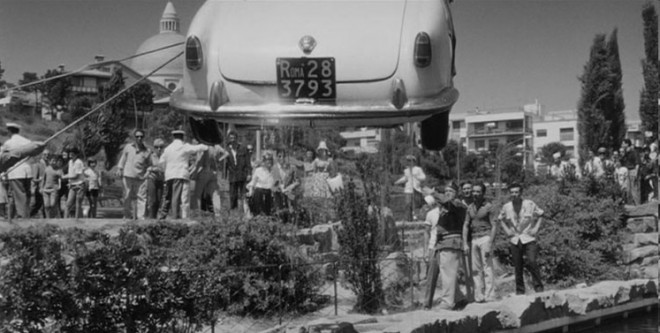A co-production from France and Russia, L’inondation or Navodneniye (The Flood), by Igor Minayev, from a novel by Yevgeni Zamyatin, is quite wonderful. Set in Petrograd in the decade following the 1917 revolution, the film stars the great Isabelle Huppert in, I would say, one of her three or four greatest performances: as Sofia, the childless wife of a hardworking miner who convinces her spouse, Trofim, to take into their home a 13-year-old orphan, Ganka, who is a bit feeble-brained. Trofim and Ganka become lovers; having a bad day, Sofia axes Ganka while her husband is at work, hacking the poor girl into a bloody pulp and disposing of the corpse. Now reconciled with her spouse, who believes that Ganka has run away, Sofia finally becomes pregnant; but the implication is that, somehow, she really gives birth to Ganka’s baby. In a Macbeth-moment, Ganka reappears to taunt poor Sofia, who confesses all in a hospital ward. Very grim, very beautifully photographed, at a measured pace that allows one to take everything in, this is a profound work about the shift from Tsarist to Communist Russia, from faith in God to faith in the people, and to the dire consequences for those, like Sofia, who remain tied to (as the subtitles put it!) the ancien régime. Very few works have homed in on this very important theme: the tumultuous upheaval of a culture and a national identity. While I watched the film, I kept thinking, Iraq.
In the Russian style that I like and some others don’t, the film moves quite slowly. But it isn’t exactly heavy. There are no scenes in the mine; but the ordeal of the miner’s backache, to which his wife must attend in order to alleviate the pain, is graphic. At that moment, the home becomes an extension of the mine; work and its aftermath overwhelm everything else. What sustains the man is the happiness of his marriage (his wife, after all, looks like Isabelle Huppert) and his sense that the Revolution has brought social justice to Russia. It is his wife, who prays, that brings discord into the home by remaining tied to Russia’s Tsarist/Orthodox Christian past. But, you know, she is only acting out what he is suppressing; he is mostly pretending how easy the transition, the upheaval of everything, is for him. In addition, he has the continuity of his labor to hold onto.
The situation is really complex. It is a Chabrolian situation that is developed along unChabrolian, more political, more national-historical lines. Huppert is there to make us think “Chabrol,” but the film turns this thought of ours inside out.
Of course, in 1994 the film is really talking about the upheaval, the change in Russia in the opposite direction—away from Communism. The political direction hardly matters, since the issue is how such a national upheaval, whatever its politics, impresses upon ordinary human lives.
B(U)Y THE BOOK
MY BOOK, A Short Chronology of World Cinema, IS CURRENTLY AVAILABLE FROM THE SANDS FILMS CINEMA CLUB IN LONDON. USING EITHER OF THE LINKS BELOW, ACCESS THE ADVERTISEMENT FOR THIS BOOK, FROM WHICH YOU CAN ORDER ONE OR MORE COPIES OF IT. THANKS.
